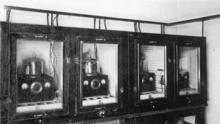The very earliest NIST work in the area of time and frequency took place within the Weights and Measures Section in Washington. One of the first objectives was the testing of watches and other timekeeping apparatus. In 1904 NIST purchased a very stable pendulum clock, the
Riefler Clock (left) from Clemens Riefler in Germany. This clock served as a time interval standard until 1929 when it was replaced by the
Shortt Clock (right), a double pendulum clock developed at Edinburgh Observatory and fabricated in London. This mechanical standard was replaced only a few years later by standards based on electronic methods.

NIST's initial involvement in electronic time-and-frequency methods was spurred by problems encountered in the early days of radio broadcasting in the United States. Commercial radio broadcasters were having difficulty keeping their broadcasts "on frequency" because they lacked adequate frequency standards. This requirement launched NBS into the development of inductance-capacitance wavemeters and then Quartz-Crystal frequency standards. In 1929, four 100 kHz quartz oscillators (below left), with auxiliary circuitry and temperature-control equipment, were installed to become the National Primary Standard of Radio Frequency. At this early date, frequency was derived from the difference of accurate measurements of mean solar time (from astronomical observations). These measurements were made regularly, because the quartz oscillators drifted in frequency by about 1 part in 10
7 per month.
In 1923, in order to meet the growing needs of the broadcast industry, NIST initiated radio broadcasts of frequency signals that continue to this day, although these now include time information as well. NIST Radio Broadcasts originated from a series of locations initially on the East Coast and later in Colorado. In the process of restating and expanding the mission of NIST in 1950, the Congress recognized the importance of this activity by including the function of "broadcasting of radio signals of standard frequency." Current NIST radio signals now emanate from broadcast stations WWV and WWVB located just north of Fort Collins, Colorado and from WWVH (right) located on the island of Kauai, Hawaii. NIST also offers two services designed to synchronize computer clocks and other automated equipment at modest accuracy levels: the Automated Computer Time Service (ACTS), and the rapidly growing Internet Time Service.
A major event in the NIST history was the development of the first
Atomic Clock (right) in 1949. This atomic clock was based on an absorption line in the ammonia molecule. An atomic clock is really just a frequency standard in which a running count of oscillations is recorded. This distinction between atomic clock and atomic frequency standard is analogous to the pendulum clock where the pendulum frequency standard is used to drive an escapement mechanism that keeps track of the ticks thus producing a clock. From the very beginning of this program, it was believed that atomic beam methods offered the best approach to an atomic frequency standard, and indeed the next seven
Atomic Frequency Standards produced by NIST were based on beams of cesium atoms. This and similar work elsewhere in the world eventually led in 1967 to a an international redefinition of the second as "the duration of 9 192 631 770 periods of the radiation corresponding to the transition between the two hyperfine levels of the ground state of the cesium-133 atom. Improvements in NIST Frequency Standards over the next five decades proceeded at a rapid rate (accuracy improvement of better than an order of magnitude every ten years) culminating in today's standard,
NIST-F1, with an accuracy of less than one second in 30 million years (less than 1 part in 10
15).
Beyond these developments, NIST is looking toward atomic frequency standards based on
Stored Ions contained in electromagnetic traps and cooled to near the absolute zero of temperature. Devices based on such stored ions have the potential for improving accuracy by better than a factor of 1000. The key to these future standards is the laser manipulation of the atomic states and motions of the atomic particles. This dependence on lasers has prompted NIST to start work on the lasers themselves. These must be further developed, modified, and simplified so that they can be used to more effectively manipulate atoms in the desired manner.
Concurrent with the development of more recent NIST atomic standards has been the development of methods for transferring time and frequency over large distances with the full accuracy of the most accurate standards. Without such transfer capability, these new atomic standards would serve no useful purpose. In the early 1980's, NIST developed the first really successful, high-accuracy technique for transferring time using satellites. This technique, called GPS Common-View Time Transfer, is now the standard method used to coordinate time among the various major timekeeping laboratories of the world. Still more accurate transfer is achieved using the methods of Two-Way Satellite Time Transfer and Carrier-Phase GPS Measurements.
With the growth of the standards and measurement methods over many years, the organizational structure of NIST's program changed. Early work took place within the Weights and Measures Section, the Electricity Division, and then the Radio Laboratory in Washington. In 1954, radio work at NIST was moved to the new Boulder Laboratories in Colorado where the work continued under the heading of the Time and Frequency Section of the Radio Standards Laboratory. In 1967, growth of the program led to the formation of the Time and Frequency Division. The final phase of the move of the WWV and WWVB radio broadcasts from the East Coast to Colorado was achieved in 1966.
An interesting aside in this history is the 1980 award by the television broadcast industry of an Emmy for contributions to the development of Closed Captioning for the Hearing Impaired. NBS work on this topic started out as a method for dissemination of time through TV broadcasts.
For a much more detailed history, please download the following paper:
D. B. Sullivan, Time and Frequency Measurement at NIST: The First 100 Years, Proc. 2001 IEEE Frequency Control Symposium, pp. 4-17, June 2001.







